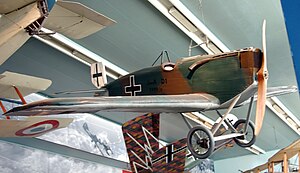You can help expand this article with text translated from the corresponding article in German. (June 2019) Click [show] for important translation instructions.
|
The Junkers D.I (factory designation J 9) was a monoplane fighter aircraft produced in Germany late in World War I, significant for becoming the first all-metal fighter to enter service. The prototype, a private venture by Junkers named the J 7, first flew on 17 September 1917, going through nearly a half-dozen detail changes in its design during its tests.[1] When it was demonstrated to the Idflieg early the following year it proved impressive enough to result in an order for three additional aircraft for trials. The changes made by Junkers were significant enough for the firm to rename the next example the J 9, which was supplied to the Idflieg instead of the three J 7s ordered.
| J 7 and J 9 (D.I) | |
|---|---|

| |
| Junkers D.I survivor at Musée de l'Air et de l'Espace | |
| Role | Fighter |
| National origin | Germany |
| Manufacturer | Junkers |
| Designer | Hugo Junkers |
| First flight | 17 September 1917 |
| Introduction | 1918 |
| Status | retired |
| Primary user | Imperial German Navy |
| Produced | 1918 |
| Number built | 41 |


During tests, the J 9 lacked the manoeuvrability necessary for a front-line fighter but was judged fit for a naval fighter and a batch of 12 was ordered. These were supplied to a naval unit by September 1918, which then moved to the Eastern Front after the Armistice.
Variants edit
- J 7
- company designation for early prototype variants, one built (three completed as J 9s).
- J 9
- company designation for late prototypes and production models
- J 9/II
- company designation for lengthened fuselage version
- D.I
- Idflieg designation
Surviving aircraft edit
One example survives and is on display in the Musée de l'Air et de l'Espace, at the Paris–Le Bourget Airport, 11km north of Paris, France. Several replicas have been built, including one on display at the Militärhistorisches Museum Flugplatz Berlin-Gatow.
Specifications edit
Data from Holmes, 2005. p 32
General characteristics
- Crew: One pilot
- Length: 7.25 m (23 ft 9.4 in)
- Wingspan: 9.00 m (29 ft 6.3 in)
- Height: 2.60 m (8 ft 6 in)
- Empty weight: 654 kg (1,438 lb)
- Gross weight: 834 kg (1,834 lb)
- Powerplant: 1 × BMW IIIa water-cooled 6-cylinder inline , 138 kW (185 hp)
Performance
- Maximum speed: 176 km/h (109 mph, 95 kn) [2]
- Endurance: 1.5 hours[3]
- Service ceiling: 6,000 m (19,700 ft)
- Rate of climb: 3.5 m/s (683 ft/min) [3]
Armament
- 2 × fixed, forward-firing Spandau machine guns
See also edit
Related development
Aircraft of comparable role, configuration, and era
References edit
Citations edit
Bibliography edit
- Grosz, Peter & Terry, Gerard (1984). "The Way to the World's First All-Metal Fighter". Air Enthusiast. Vol. 25, no. Aug-Nov 1984. pp. 60–76. ISSN 0143-5450.
- Grosz, P.M. (1992). Junkers D.I. Windsock Datafile 33. Hertfordshire, UK: Albatros Publications. ISBN 978-0948414-41-1.
- Holmes, Tony (2005). Jane's Vintage Aircraft Recognition Guide. London: Harper Collins. ISBN 0007192924.
- Kay, Anthony L. (2004). Junkers Aircraft and Engines 1913-1945. London: Putnam. ISBN 0-85177-985-9.
- Owers, Colin A. (2018). Junkers Aircraft of WWI: Volume 2: Junkers J.5–J.11: A Centennial Perspective on Great War Airplanes. Great War Aviation Centennial Series. Vol. 31. n.p.: Aeronaut Books. ISBN 978-1-935881-66-7.
Further reading edit
- Zuerl, Walter (1941). Deutsche Flugzeug Konstrukteure. München, Germany: Curt Pechstein Verlag.